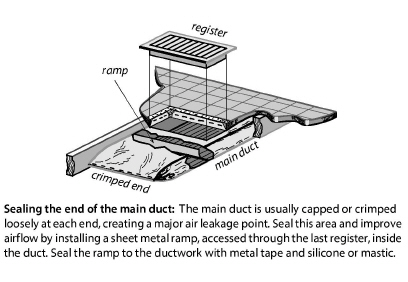
The location and relative importance of mobile home air leaks was a mystery before blower doors. Some mobile homes are fairly airtight, and others are very leaky. Air leakage serves as ventilation in most mobile homes. Comply with the whole-building ventilation standards outlined in “Whole-Building Ventilation” on page 354.
A duct airtightness tester, which pressurizes the ducts and measures their air leakage, is the best way to measure and evaluate duct air sealing. See “Evaluating Duct Air Leakage” on page 306. For simply locating duct leaks, the blower door used in conjunction with a pressure pan does a good job. See "Pressure Pan Testing" on page 307.
Most mobile home duct sealing is performed through the belly. This work is more difficult once the belly has been re-insulated. Inspect the ductwork and seal any major leaks, such as disconnected trunk lines, before insulating the belly.
|
Air Sealing Procedure |
Typical CFM50 Reduction |
|---|---|
|
Patching large air leaks in the floor, walls and ceiling |
200–900 |
|
Sealing floor cavity used as return-air plenum (See “Floor return air” on page 426.) |
300–900 |
|
Sealing leaky water-heater closet |
200–600 |
|
Sealing leaky supply ducts |
100–500 |
|
Installing tight interior storm windows |
100–250 |
|
50–150 |
Mobile home shell air leakage is often substantially reduced when insulation is installed in roofs, walls, and belly cavities. Prioritize your efforts by performing these tasks in this order.
1. Evaluate the insulation levels. If adding insulation is cost-effective, perform the usual pre-insulation air sealing measures that also prevent spillage of insulation out of the cavity.
2. Install cavity insulation. Perform duct sealing first if the belly is to be insulated.
3. Re-check the air leakage rate.
4. Perform additional air sealing as needed.
11.1.1 Shell Air Leakage Locations
Blower doors have pointed out the following shell locations as the most serious air leakage sites.
ü Plumbing penetrations in floors, walls, and ceilings. Water-heater closets with exterior doors are particularly serious Air Leakage problems, having large openings into the bathroom and other areas
ü Torn or missing underbelly, exposing flaws in the floor to the ventilated crawl space
ü Large gaps around furnace and water heater chimneys
ü Severely deteriorated floors in water heater compartments
ü Gaps around the electrical service panel box, light fixtures, and fans
ü Joints between the halves of double-wide mobile homes and between the main dwelling and additions
Note: Window and door air leakage is more of a comfort problem than a serious energy problem.
Blower doors and duct testers have pointed out the following duct locations as the most serious energy problems.
ü Floor and ceiling cavities used as return-air plenums — These floor return systems should be eliminated and replaced with return-air through the hall or a large grille in the furnace-closet door.
ü Joints between the furnace and the main duct — The main duct may need to be cut open from underneath to access and seal these leaks between the furnace, duct connector, and main duct. With electric furnaces you can access the duct connector by removing the resistance elements. For furnaces with empty A-coil compartments, you can simply remove the access panel to seal the duct connector.
ü Joints between the main duct and the short duct sections joining the main duct to a floor register
ü Joints between register boots and floor
ü The poorly sealed ends of the duct trunk, which often extend beyond the last supply register
ü Disconnected, damaged or poorly joined crossover ducts
ü Supply and return ducts for outdoor air conditioner units
ü Holes cut in floors by tradesmen.
ü New ductwork added to supply heat to room additions
Be sure to seal floor penetrations and ductwork before performing any belly repair. Pollutants in the crawl space such as mold and dust will be disturbed by repair work and can be drawn into the home by duct depressurization.
See “Pressure Pan Testing” on page 307. See “Sealing Supply Ducts” on page 316.
Mobile home supply duct leaks pressurize the belly cavity. Follow these steps to perform this rough test to determine if duct leaks are present and their general location.
ü Repair the rodent barrier.
ü Turn on the air handler.
ü Insert a manometer hose into the belly through the rodent barrier and test the pressure with-reference-to the outdoors.
ü Start near the furnace, and work your way toward the ends alongside the trunk line. A pressure rise gives you a rough idea of the location of leaks, size of leaks, and tightness of the nearby rodent barrier.
ü Repair the ducts and re-test.


